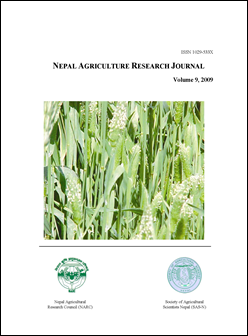Use of Ethephone and Indigenous Plant Materials in Ripening Banana in Winter
DOI:
https://doi.org/10.3126/narj.v9i0.11649Keywords:
Banana, Ethephone, Plant materials, Ripening, Shelf-lifeAbstract
Post-harvest handling of banana is a crucial activity to get good quality fruit to the consumers. A post-harvest study on ripening of banana was carried out at Regional Agriculture Research Station, Khajura during winter season of 2005 to find out the effect of different materials in ripening of banana and study about shelf-life period. Dipping fruits in Kripone 2.56 ml per liter of water (ethephone 1000 ppm) for five minutes was found effective for banana ripening. Those fruits treated with ethephone 1000 ppm started to soften in three days and became ready to consume in five days with shelf-life of eight days. Fruits treated with 'Asuro' (Adhatoda vesica) started to become soft in five days where as fruits treated with 'Koiralo' (Bahunia veriagata) became soft in four days. By using these indigenous plant materials, we can prolong shelf-life of fruit by 2-3 days more than the Kripone-treated fruits. Use of ripe banana fruit also found effective to hasten ripening the banana with excellent taste. However, the shelf-life was relatively short (8 days). It is difficult to ripen the banana in winter without using any ripening materials. In untreated control, only 33% fruits started to become soft after 7-9 days of storage and were ready to consume in nine days. Rest 66% fruits were remain as such up to 11 days then after fruit started uneven softening ie some portion became soft and other portion remained hard. After 14 days fruits became black without softening and got spoiled. Overall percent weight loss was found 6.0 to 10.7 from initial to end of shelf-life period.
Nepal Agric. Res. J. Vol. 9, 2009, pp. 113-117
Downloads
Downloads
Published
How to Cite
Issue
Section
License
This license allows reusers to copy and distribute the material in any medium or format in unadapted form only, for noncommercial purposes only, and only so long as attribution is given to the creator.




